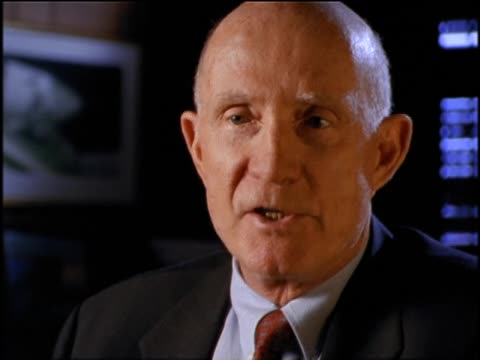NOVA; To the Moon; Interview with Thomas P. Stafford, NASA astronaut, Air Force Officer, and Commander of Apollo 10, part 3 of 3
- Series
- NOVA
- Episode
- To the Moon
- Producing Organization
- WGBH Educational Foundation
- Contributing Organization
- WGBH (Boston, Massachusetts)
- AAPB ID
- cpb-aacip-15-7940r9n96v
If you have more information about this item than what is given here, or if you have concerns about this record, we want to know! Contact us, indicating the AAPB ID (cpb-aacip-15-7940r9n96v).
- Description
- Program Description
- This remarkably crafted program covers the full range of participants in the Apollo project, from the scientists and engineers who promoted bold ideas about the nature of the Moon and how to get there, to the young geologists who chose the landing sites and helped train the crews, to the astronauts who actually went - not once or twice, but six times, each to a more demanding and interesting location on the Moon's surface. "To The Moon" includes unprecedented footage, rare interviews, and presents a magnificent overview of the history of man and the Moon. To the Moon aired as NOVA episode 2610 in 1999.
- Raw Footage Description
- Thomas P. Stafford, NASA astronaut, Air Force Officer, and Commander of Apollo 10, is interviewed about Apollo 10 and his later career. He explains why Gene Cernan swore during the mission as a scary moment when the spacecraft briefly spun out of control, and mentions his regrets at never reaching the moon. After Apollo, Stafford worked with the Russians on the Apollo-Soyuz project, and later worked as part of a synthesis group to determine the United States' ability to go to Mars, after President George H.W. Bush suggested Mars as a goal in 1989. However, the the timing was poor because of the fall of the Soviet Union, but Stafford suggested that a trip to Mars could still be possible. The interview ends with Stafford's statement that Apollo was the highlight of his career.
- Created Date
- 1998
- Asset type
- Raw Footage
- Genres
- Interview
- Topics
- History
- Technology
- Science
- Subjects
- American History; Gemini; apollo; moon; Space; astronaut
- Media type
- Moving Image
- Duration
- 00:12:34
- Credits
-
-
Producing Organization: WGBH Educational Foundation
- AAPB Contributor Holdings
-
WGBH
Identifier: cpb-aacip-455ce3ac11a (Filename)
Format: Digital Betacam
Generation: Original
Duration: 0:12:34
If you have a copy of this asset and would like us to add it to our catalog, please contact us.
- Citations
- Chicago: “NOVA; To the Moon; Interview with Thomas P. Stafford, NASA astronaut, Air Force Officer, and Commander of Apollo 10, part 3 of 3 ,” 1998, WGBH, American Archive of Public Broadcasting (GBH and the Library of Congress), Boston, MA and Washington, DC, accessed December 8, 2025, http://americanarchive.org/catalog/cpb-aacip-15-7940r9n96v.
- MLA: “NOVA; To the Moon; Interview with Thomas P. Stafford, NASA astronaut, Air Force Officer, and Commander of Apollo 10, part 3 of 3 .” 1998. WGBH, American Archive of Public Broadcasting (GBH and the Library of Congress), Boston, MA and Washington, DC. Web. December 8, 2025. <http://americanarchive.org/catalog/cpb-aacip-15-7940r9n96v>.
- APA: NOVA; To the Moon; Interview with Thomas P. Stafford, NASA astronaut, Air Force Officer, and Commander of Apollo 10, part 3 of 3 . Boston, MA: WGBH, American Archive of Public Broadcasting (GBH and the Library of Congress), Boston, MA and Washington, DC. Retrieved from http://americanarchive.org/catalog/cpb-aacip-15-7940r9n96v
